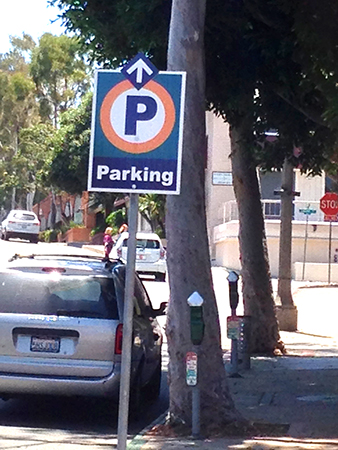
About 60 residents and numerous city officials attended a public workshop Tuesday to discuss getting around town and preliminary recommendations for improving the experience of pedestrians, cyclists and riders of public transport. A loose consensus evolved that the city needs to better accommodate the needs of all three groups, and that many people would be willing to swap at least some parking spaces as a trade-off for biking and walking amenities.
Participants strongly supported the idea of capturing visitors’ cars in peripheral lots, with reliable public transit, bike and pedestrian routes to link them to downtown shopping and beaches. They also embraced a number of suggested improvements, such as closing gaps in the sidewalk network, installing more advanced crosswalks, pedestrian-only zones, bike lanes buffered from cars, and more user-friendly bus routes and schedules. Painted symbols indicating bike-sharing routes were largely derided as “better than nothing,” and at best a sort of placeholder for a more practical solution.
Floating their own ideas, residents pointed out that alleviating congestion downtown means accommodating two groups of users, visitors and residents, who need two sets of solutions. Some suggested that the hospitality industry be might help subsidize improved transit for visitors. Rita Conn, of Let Laguna Vote, said that one way to help meet residents’ needs would be to do away with the taxi voucher system in favor of bringing in the more efficient service such as Uber car or Lyft.
The workshop aimed to present results from and get public input on two concurrent and interrelated studies: RBF Consulting’s effort to outline a citywide network accounting for the needs of pedestrians, cyclists and motorists including reliable public transit options; and IBI Group’s evaluation the city’s $2.2 million public transit system with a view to encouraging new users.
Both groups previously solicited public input, including a citywide transit survey that elicited responses from over 2,000 residents and a public walk/ride in which about 50 locals stepped and/or peddled out with city staff and the project team to explore parts of Laguna Beach from the vantage of cyclists and pedestrians.
Leading the workshop Tuesday, RBF’s Susan Harden went over results gleaned so far and presented a series of “very preliminary” recommendations, before encouraging discussion among smaller groups.
It’s all about creating a balance and reducing congestion to create and environment that supports all forms of mobility, said Harden.
Harden pointed out that their examination of mobility and transit had bearing on a number of simultaneous efforts going on in the city, such as an update of the downtown specific plan, an analysis of Laguna Canyon Road, the start of off-season trolley service and the parking management plan. This last, notably, resulted in the upgrading of all parking meters to accommodate credit cards, raised meter rates, and most recently a uniform signage plan to clearly identify available parking locations throughout the city.
Sitting at ten tables, accommodating up to eight people each, participants began deliberations, equipped with maps of bus, pedestrian and bike routes, as well as information packets tabulating study results and outlining possible solutions.
The tables also included hand-held electronic polling devices so that when the small groups wrapped up, everyone in the room could vote on multiple choice questions that Harden presented, with the results appearing on screen an instant later.
In this way, Harden determined that most participants came to the workshop by car, with 61 percent riding alone and 20 percent carpooling. Additional polls revealed that while “voters” were divided over the effectiveness of proposed pedestrian improvements, the majority believed that we still have “a way to go” in coming up with the best solutions for transit and bike routes.
We need to move beyond one-off improvements and create a grassroots walking, biking and transit culture that will support real changes in the way we all get around town, said Conn.
To learn more, find study results and review materials presented at the workshop on the city’s website.




